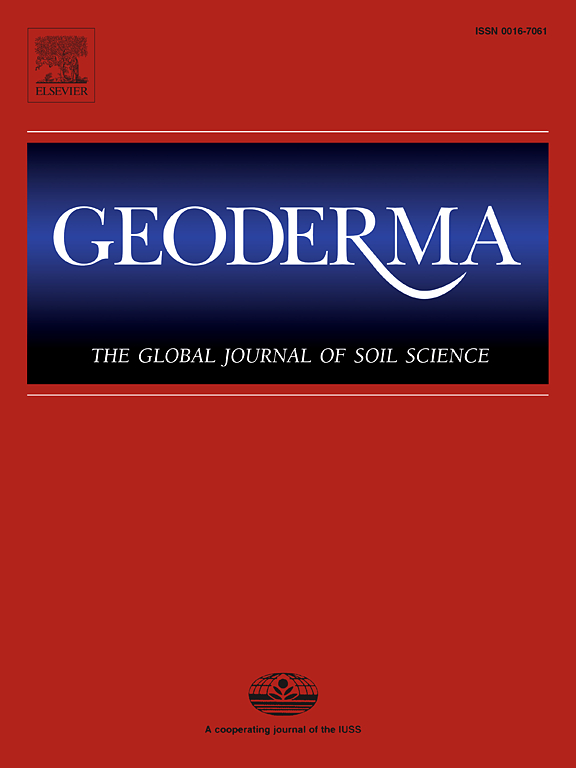Active motility and chemotactic movement regulate the microbial early-colonization and biodiversity
IF 6.6
1区 农林科学
Q1 SOIL SCIENCE
引用次数: 0
Abstract
Microbial dispersal and subsequent colonization of new niches are fundamental processes in microbial ecology, particularly in patchy environments like soil. However, the heterogeneity of soil pore spaces and the resulting fragmented aqueous habitats are known to significantly impede microbial dispersal rates and ranges. Despite this, the strategies microbes employ to overcome these abiotic constraints remain poorly understood. To address this, we developed a novel experimental system using porous ceramic surfaces to simulate hydrated soil environments, enabling direct quantification of early-stage bacterial colonization. Our findings reveal that distinct taxonomic and functional bacterial populations successfully colonized the porous ceramic surfaces, differing significantly from the original soil communities. Active motility and chemotaxis emerged as two key traits facilitating early-stage colonization. However, the advantages conferred by motility and chemotaxis were significantly reduced under drier soil conditions, typically at water contents below 25% (v/v). Under such conditions, non-motile bacteria relied on passive dispersal mechanisms or physical adhesion to colonize the porous surfaces. Furthermore, functional metagenomic profiling of the colonizing microbial populations uncovered a trade-off between growth and dispersal rates. This observed trade-off was incorporated into an agent-based model simulating microbial activity in soil, which explored how correlations between microbial functional genes influence community dynamics during early colonization. The simulations demonstrated that the growth-dispersal trade-off is crucial for enhancing and maintaining microbial diversity during colonization of new niches. Our study elucidates the key biophysical mechanisms driving microbial early-stage colonization dynamics from bulk soil to new environments, highlighting this process as a core ecological phenomenon in soil ecosystems.
主动运动和趋化运动调节微生物的早期定植和生物多样性
微生物的扩散和随后的新生态位的定植是微生物生态学的基本过程,特别是在像土壤这样的斑块环境中。然而,土壤孔隙空间的不均一性和由此产生的破碎的水栖环境阻碍了微生物的扩散速度和范围。尽管如此,微生物用来克服这些非生物限制的策略仍然知之甚少。为了解决这个问题,我们开发了一种新的实验系统,使用多孔陶瓷表面来模拟水化土壤环境,从而可以直接量化早期细菌定植。我们的研究结果表明,不同的分类和功能细菌群体成功地定植在多孔陶瓷表面,与原始土壤群落明显不同。主动运动性和趋化性是促进早期定植的两个关键特征。然而,在干燥的土壤条件下,通常在含水量低于25% (v/v)时,运动性和趋化性所带来的优势显着降低。在这种条件下,不活动的细菌依靠被动扩散机制或物理粘附来定植多孔表面。此外,对定植微生物种群的功能宏基因组分析揭示了生长和扩散速度之间的权衡。这种观察到的权衡被纳入到一个基于主体的模型中,模拟土壤中的微生物活动,该模型探索了微生物功能基因之间的相关性如何影响早期定植过程中的群落动态。模拟结果表明,在新生态位的定殖过程中,生长-扩散权衡对于增强和维持微生物多样性至关重要。我们的研究阐明了驱动微生物从散装土壤到新环境的早期定植动力学的关键生物物理机制,强调了这一过程是土壤生态系统中的核心生态现象。
本文章由计算机程序翻译,如有差异,请以英文原文为准。
求助全文
约1分钟内获得全文
求助全文
来源期刊

Geoderma
农林科学-土壤科学
CiteScore
11.80
自引率
6.60%
发文量
597
审稿时长
58 days
期刊介绍:
Geoderma - the global journal of soil science - welcomes authors, readers and soil research from all parts of the world, encourages worldwide soil studies, and embraces all aspects of soil science and its associated pedagogy. The journal particularly welcomes interdisciplinary work focusing on dynamic soil processes and functions across space and time.
 求助内容:
求助内容: 应助结果提醒方式:
应助结果提醒方式:


